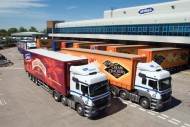 Logistex is an independent solutions integrator managing the design, development, commissioning and support for manual and automated warehouse systems. With its in-house developed WMS and the freedom to select the most appropriate equipment to deliver the most cost-effective solutions, Logistex offers a comprehensive service to customers ranging from SMEs to blue-chip companies.
Logistex is an independent solutions integrator managing the design, development, commissioning and support for manual and automated warehouse systems. With its in-house developed WMS and the freedom to select the most appropriate equipment to deliver the most cost-effective solutions, Logistex offers a comprehensive service to customers ranging from SMEs to blue-chip companies.
With a pedigree of more than 70 years in the industry, the company has seen many changes and has evolved unrivalled expertise in assessing customer requirements and creating innovative solutions across a diverse range of markets and services.
Logistex’s Business Development Director Derek Kay talked to Warehouse and Logistics News about the company’s history, values and a business model adapted to today’s market.
Warehouse and Logistics News – what would you say are the core areas of expertise at Logistex?
There are four main areas in which we believe we have exceptional expertise – Warehouse Management Software, customer service and engineering support, automated warehouse solution design and professional project delivery. We believe our underlying strength lies in our residential and field service teams who support our extensive customer base with engineering and facilities management services.
Our technical strength comes from our in house developed Warehouse Management System, LWS Reflex. Our innovative strength comes from our solution development team who can analyse a warehousing requirement and create a cost-effective solution with fast payback ROI. Our project delivery strength comes from our APM qualified project management team and strong in house processes.
Warehouse and Logistics News – Logistex is described as an independent logistics systems integrator – how does this work and what does it mean for the end user?
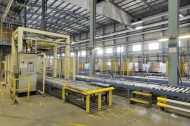 The traditional business model in the industry has been – and often continues to be – one company designing and manufacturing a range of products and technologies designed for a specific project. While this has proved to be a practical business model for many years, its limitations have emerged and have adversely affected many in the business. Factories need to be fed with a constant supply of orders to be viable, almost regardless of economic conditions, and as technologies become more complex and diverse, few suppliers can afford the resources to keep pace. At the same time, many new companies have been introducing more specialist niche solutions that have the potential to deliver more innovative solutions to the end user, but do not have the expertise to create a fully integrated solution.
The traditional business model in the industry has been – and often continues to be – one company designing and manufacturing a range of products and technologies designed for a specific project. While this has proved to be a practical business model for many years, its limitations have emerged and have adversely affected many in the business. Factories need to be fed with a constant supply of orders to be viable, almost regardless of economic conditions, and as technologies become more complex and diverse, few suppliers can afford the resources to keep pace. At the same time, many new companies have been introducing more specialist niche solutions that have the potential to deliver more innovative solutions to the end user, but do not have the expertise to create a fully integrated solution.
Two years ago the Logistex management team undertook a thorough business review to create a vision of how the business should be structured to make best use of our resources and to provide the greatest value to our clients. We concluded that using our skills and experience to evaluate the client’s business, to determine the most productive, practical and cost-effective solution and to deliver a completed project was the right direction for the business. We would research and source whatever products and systems judged to be most suitable for each project from the hundreds of innovative and productive companies serving the industry internationally.
In this way we could create a leaner, more flexible and responsive business unit, without being diverted by the need to manage and feed a high cost-base factory. The reaction of clients and others in the industry has been very positive as they see the business sense, both for the industry and its clients.
Warehouse and Logistics News – Has this change in strategy affected your relationships with existing suppliers or even your competitors?
Reaction so far has been very positive. Some manufacturing competitors no longer see us as a direct rival as we may well select products from their ranges to meet a specific need. While we keep an open mind on every project, we are progressively building up a list of partners with whom we believe we could work well, with the right quality of products and the desire to work with us. We’re even working with other integrators to provide maintenance and support where their own infrastructure does not meet their customers’ requirements.
Warehouse and Logistics News – you talk about history and legacy. What is the company’s background and who owns the business now?
The name Cleco will be familiar to those who have been in the industry for some time. For many years it was one of the strongest and most respected companies in the industry, designing and manufacturing materials handling products including VNA automated stacker cranes with which the company was most associated. Even then, the company supplied integrated solutions based on bought in products from other materials handling manufacturers as well as in-house equipment, so the business model we are now pursuing is one that is familiar to the company’s culture.
As the use of IT and software systems entered the mainstream of warehouse operations, Cleco merged with software house lo Systems, with whom the company had a long-term partnership, to provide the additional expertise needed to support its own increasingly sophisticated systems. This commitment to specialist in-house IT expertise remains part of the company’s DNA to this day, with the average length of service in the systems team being 10 years.
Following a management buyout from former owners Melrose PLC, Logistex is now a fully independent business, managed by the team which turned the business round into a financially robust, profitable and successful organisation. The MBO was achieved without external financial support, leaving the company debt-free and with a strong balance sheet. The company is based in a modern office block in Kettering, Northamptonshire, and employs over 200 people throughout the country.
Warehouse and Logistics News – so software systems are still an important part of what you have to offer?
![]() Very much so. Our LWS Reflex software product is a comprehensive, configurable warehouse management system (WMS). It has been designed to be highly flexible and scalable, and is able to provide door to door warehouse management control automation and manage data associated with supply chain applications. Systems can be implemented as a standalone operation or part of a broader WMS solution.
Very much so. Our LWS Reflex software product is a comprehensive, configurable warehouse management system (WMS). It has been designed to be highly flexible and scalable, and is able to provide door to door warehouse management control automation and manage data associated with supply chain applications. Systems can be implemented as a standalone operation or part of a broader WMS solution.
Our LWS Reflex WMS software provides an outstanding example of our policy of developing innovative and cost-effective systems. Users have the unrivalled freedom to pick and pay for any selection from a comprehensive suite of pre-installed features as and when required. Options can be activated or de-activated with no long-term commitment at any time. As an intelligent, optional and scalable system, it can grow and flex as business volumes and needs change. With the entry level below £30,000, it can make good business sense for small to medium companies and may indeed ensure they never need to pay for another WMS.
If proof were needed, we have Logistex software systems working for clients as diverse as Coca Cola, Wincanton/GSK, United Biscuits, DHL, VOW Europe and ARCO.
Warehouse and Logistics News – are there any markets that LWS will appeal to particularly?
We designed LWS Reflex to make it easily accessible for small to medium companies, but its ability to match Big Company performance means that should they become major players in their field, they may never need to pay for another WMS.
However there is no doubt that LWS Reflex has huge potential in the exploding e.commerce market sector. It provides all the functionality required from stock placement, location, picking, packaging and dispatch – and is able to interface with the client’s own web ordering process and courier software. So the one system provides a seamless data management and interchange for the entire stock process, without double entry or duplicate functions.
With all the advanced management capabilities of a high volume, large-scale system, LWS Reflex provides any internet-based business with the tools to maximise stock profiles and levels in line with demand and ensuring fast, accurate deliveries. Most WMS and stock management systems eventually need to be upgraded as a business evolves – but at a cost. However LWS Reflex provides a comprehensive package of functionalities and features – suitable for any task from basic manual systems up to complex operations incorporating high levels of automation – that will stay with the user from start-up to big company performance. It’s simple, flexible and gives companies an unrivalled business tool that adapts to changes in demand and commercial patterns without the straightjacket of a long-term commitment – with fast payback and ROI.
Warehouse and Logistics News – companies are looking to suppliers taking on a wider role than ever. Do you have any plans to extend your services?
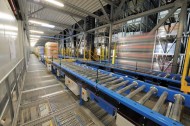 During the earlier evaluation I mentioned we identified the wide range of skills our service teams had to offer in areas such as electrics and electronics, engineering, heating and other disciplines. With on-site support teams we could see that these skills could be used to provide a far wider range of services to the client, using the time when they were not working on Logistex supplied systems.
During the earlier evaluation I mentioned we identified the wide range of skills our service teams had to offer in areas such as electrics and electronics, engineering, heating and other disciplines. With on-site support teams we could see that these skills could be used to provide a far wider range of services to the client, using the time when they were not working on Logistex supplied systems.
As a result we proposed providing Engineering Support services with our existing staff to a number of clients, who responded favourably to the concept. Not only are we able to respond far more rapidly than would be possible for an outside contractor, but we have seen the potential to greatly reduce the cost of the service. And few companies can turn down the offer of a better service at a lower price!
We’re also able to use our extensive field based team to provide cost effective services either for planned preventive maintenance or an ad-hoc service for customers with any engineering requirement.
For a major 3PL based in Oxfordshire, we are now providing full Site Engineering and Facilities Maintenance support covering almost every aspect of the building and systems – including handling and storage equipment, heating and energy management, utilities and services, building fabric inspections, safety and environmental issues, legislation compliance and insurance.
Warehouse and Logistics News – despite the best efforts of the industry, many SMEs in the UK still believe that advanced logistics systems are either not right for them or that they cannot afford the capital cost. Do you see this changing?
While many of our clients are global blue chip companies, we believe to be successful we must provide systems and services that will appeal to SMEs, some of whom will of course be tomorrow’s global giants. Our LWS Reflex WMS is a good example of providing small but growing organisations with access to high performance stock management software at an affordable pricing structure. It’s available through a number of cost models, from direct purchase to Software as a Service (SaaS), and as customers do not pay per user there are no licencing penalties as usage increases.
As to systems – we believe it is more important to work with the company to ensure we recommend the most productive and practical solution: and above all to see that the business case is clearly identified and presented, so the client can grasp the merit in making a positive decision, and that what is proposed will add bottom line profits.
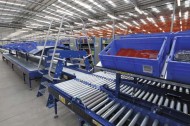 We like to start with a blank board and to encourage maximum client input at the information gathering stage, asking questions and generating ideas. The Logistex team will then have the brief to turn design concepts into detailed, engineered solutions, ones that address operational challenges whilst minimising capital investment.
We like to start with a blank board and to encourage maximum client input at the information gathering stage, asking questions and generating ideas. The Logistex team will then have the brief to turn design concepts into detailed, engineered solutions, ones that address operational challenges whilst minimising capital investment.
As part of the evaluation stage we have developed our own software tools to help clients assess the long-term financial viability of a variety of logistics and automation schemes. The process compares various investment scenarios – such as the proposed system and an alternative – and calculates the ROI or payback period.
Warehouse and Logistics News – the type of automated solutions you can supply are inevitably a major capital cost. What can be done – particularly in the present environment – to get the maximum life from such systems?
The most obvious answer is to ensure that the equipment is maintained and repaired as required by competent and trained technicians to ensure minimum downtime and maximum throughput during the life of the system. As you might expect, we operate a comprehensive after-sales service for the lifetime of any system or equipment supplied, including full service and maintenance, field service operatives, on-site service teams, customer training, spare parts and dedicated hotline support, round the clock, every day of the year.
However even the finest equipment will progressively wear out and over the years, become obsolete in the face of improved designs and technologies. The huge advances in IT and software for example in the past few years have way outstripped what would have been state of the art barely a decade ago. One of the most encouraging aspects of our business over the past few years is the number of existing Logistex clients who have commissioned us to refurbish and upgrade their equipment. We are pleased of course to have the business – but even more so when we see a company adding perhaps another decade of life, higher performance and improved reliability – at a fraction of the cost of replacement.
An often mentioned fear is the risk of component failure – which can adversely affect throughput and delivery expectations – which increases as systems begin to age. Losing functionality for a short time can be disruptive but extended downtime can have a far more serious impact throughout the organisation, leading to a loss of confidence and business.
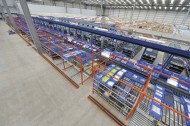 Refurbishment and upgrading may improve performance and add years of productive life to automated materials handling systems – at usually far less cost than a new installation. It also enables the user to take advantage of the big improvements in engineering, software and technologies over the past few years. The latest software including our advanced WMS provides enhanced performance, full integration with ERP systems and other client software packages.
Refurbishment and upgrading may improve performance and add years of productive life to automated materials handling systems – at usually far less cost than a new installation. It also enables the user to take advantage of the big improvements in engineering, software and technologies over the past few years. The latest software including our advanced WMS provides enhanced performance, full integration with ERP systems and other client software packages.
Work can generally be carried out while the business continues to operate, which is rarely possible when replacing an entire system. With an increasing focus on health and safety, a refurbishment programme may well reduce the risk of accidents from older equipment and the upgrade could incorporate additional safety features to protect staff.
Logistex has carried out a number of refurbishment projects for existing clients including Wincanton/ GlaxoSmithKline, United Biscuits, Inditex (Zara) and Spicers.
Warehouse and Logistics News – Can you give us some more detail of the kind of projects you have completed, both new and refurbishments?
The easiest way is to give a snapshot summary of some recent assignments.
Coca Cola Romania
New automated high-bay rack-clad warehouse in Ploiesti for Coca-Cola Hellenic Bottling Company (CCHBC), successfully delivered within a demanding timescale without affecting on-site production. 30m high pallet rack clad structure designed to withstand demanding seismic conditions holds 35,000 pallets, is served by 11 twin pallet cranes managed by a Logistex WMS.
Wincanton/GlaxoSmithKline
Two contracts completed for Wincanton plc to upgrade Automated Storage and Retrieval Systems (ASRS) in distribution centres operated by Wincanton on behalf of GlaxoSmithKline (GSK).
The first contract was to add two high bay storage aisles with narrow aisle cranes to the existing nine aisles installed by Logistex, as well as additional racking and conveyors, in Wincanton’s GSK Distribution Centre at Middlewich, Cheshire. The second contract was to upgrade the ASRS – originally installed by a different supplier – at Wincanton’s GSK Distribution Centre at Brockworth, near Gloucester.
United Biscuits
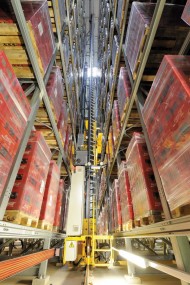 Recently refurbishment and upgrade for 22 automated high bay cranes originally installed by Logistex in United Biscuits’ 58,000 pallet capacity Ashby-de-la-Zouch Midland Distribution Centre. A combination of innovative upgrading and refurbishment technologies has resulted in significant improvements in productivity, service and safety, including a 27% increase in capacity, errors down by nearly a half, and faster, safer repair and maintenance procedures.
Recently refurbishment and upgrade for 22 automated high bay cranes originally installed by Logistex in United Biscuits’ 58,000 pallet capacity Ashby-de-la-Zouch Midland Distribution Centre. A combination of innovative upgrading and refurbishment technologies has resulted in significant improvements in productivity, service and safety, including a 27% increase in capacity, errors down by nearly a half, and faster, safer repair and maintenance procedures.
VOW Europe
Full consultation and design service provided throughout the planning stage using Logistex’s Situational Analysis and client’s own historical data. The proposal was designed to consolidate several warehouses into a single distribution centre. The installation consists of a one-kilometre carton picking conveyor, a full case pick line operating at up to 2,000 containers per hour and sorter handling up to 2,850 items per hour. Logistex’s own WMS is integrated with the client’s Manhattan WMS.
Warehouse and Logistics News – the company has traditionally operated internationally. Is this still the case?
While most of our business is in the UK, we continue to operate in a number of overseas countries. As well as the Coca Cola Romania project, we have recently completed a €1m upgrade for Tetra Pak’s world spares facility in Sweden, developed and installed an innovative pilot handling concept for FloraHolland in the Netherlands, and have a number of other international projects close to fruition.
Warehouse and Logistics News – Do you see many more changes in the business?
No business can stand still if it hopes to succeed in a competitive market. What is important however is to have a clear vision of the products and services offered to the market and what they can deliver as a positive business proposition to the client. Our purpose is to help our clients run their businesses more effectively and profitably through the most efficient storage and handling methods and technologies available. How we go about that will constantly change as we strive to improve the service we offer. The ultimate aim of delivering a successful investment for the client will not.
Logistex
Tel: 01536 480 600




Comments are closed.